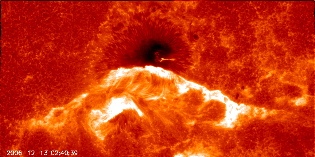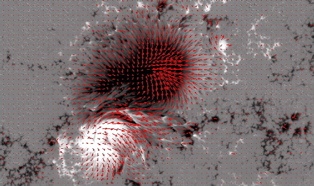“Hubble for the Sun”
Astronomers are calling the Japanese Hinode
spacecraft a “Hubble for the sun.”
Astronomers are calling the Japanese Hinode spacecraft a “Hubble for
the sun.” Watch this movie and you’ll see why: The footage, gathered
by Hinode’s Solar Optical Telescope (SOT) on Dec. 13, 2006, shows sunspot
930 unleashing a powerful X-class solar flare.
“Solar flares are essentially magnetic,” John Davis explains. In the maelstrom above a sunspot, lines of magnetic force are twisted and stretched until the tension reaches a certain point-and then the whole thing explodes.
Regard the animation below. It looks like a rampaging hurricane–about twice as wide as Earth! In fact, it is a magnetic map of the flare zone on the southern flanks of sunspot 930. Red arrows indicate the direction of the sunspot’s magnetic field. White areas have positive polarity (N); black areas are negative (S).
On Dec. 13, 2006, at precisely 0234 UT, the energy was released in the form of an X3-category solar flare. The explosion hurled a coronal mass ejection (CME: a billion-ton cloud of gas) into space, which sparked Northern Lights as far south as Arizona when it hit Earth a day later.
Posted: Wed - April 25, 2007 at 12:26 PM

